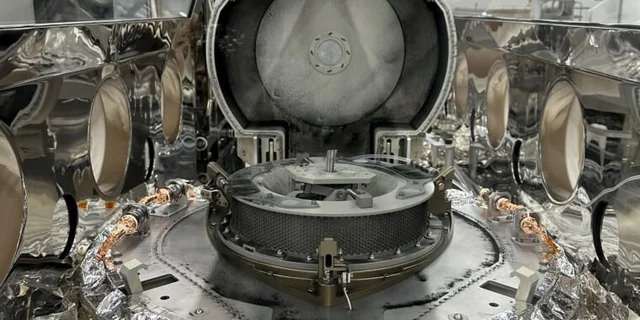
Opening the aluminum canister that held fragments of an ancient space rock has finally shown the majority of the asteroid Bennu sample in all its splendor.
The TAGSAM (Touch-and-Go Sample Acquisition Mechanism) head was successfully opened earlier this month by NASA's OSIRIS-REx team thanks to the development of new tools to address two jammed fasteners that obstructed the asteroid sample. When NASA eventually opened the sampler head, the remaining hidden samples were visible, and woah, there was a whole lot of asteroid inside. For scientific teams waiting for a piece that might hold information about the solar system's origin, this is fantastic news.
According to NASA, the image below was taken using a semi-automated focus stacking process and manual high-resolution precision photography by project lead Joe Aebersold and creative lead Erika Blumenfeld for the Advanced Imaging and Visualization of Astromaterials (AIVA).
Before the majority of the asteroid sample is extracted, a few procedures need to be completed. After removing the circular metal collar, the curation team will empty the remaining sample from the TAGSAM head into pie-slice-shaped sample trays that are smaller. At NASA's Johnson Space Center in Houston, Texas, these trays will be taken pictures of before the sample is weighed, packed, and kept.
The precise amount of asteroid material that the OSIRIS-REx spacecraft brought to Earth will be revealed by the sample's weight, which is still unknown. The avionics deck of the sample canister had debris and black dust on it when the aluminum lid was first removed by the team. Additionally, they used tweezers or a scoop to remove some of the material from inside the canister while holding down the mylar flap of the TAGSAM head. A total of 8.8 ounces (250 grams) of rock and dust have been weighed out of the sample so far. NASA has already exceeded its target of delivering at least 2.12 ounces (60 grams) to Earth just with the bonus sample.
Launched in September 2016, the OSIRIS-REx mission arrived at Bennu, the asteroid, in December 2018. In October 2020, the spacecraft captured fragments of a small near-Earth asteroid, and in May 2021, it started returning to Earth.
September 2023 saw the spacecraft drop the sample in the Utah desert, but NASA has been having difficulty opening a circular sampler head that was attached to an articulated arm that the spacecraft used to retrieve the sample. The curation team started working on creating new instruments that would fit into the glovebox that houses the canister in November, and it has now successfully removed those annoying fasteners.
In order to thoroughly examine Bennu's composition, 230 scientists from around the world will be part of the sample analysis team that will receive the returned asteroid fragments. In an attempt to capitalize on cutting-edge technology in the upcoming years, NASA plans to preserve a minimum of 70% of the sample at Johnson Space Center for research conducted in the future decades from now. The Smithsonian Institution, Space Center Houston, and the University of Arizona will all be able to view a portion of the asteroid fragments for the general public.
A tiny asteroid called Bennu passes very close to Earth about once every six years. Researchers think that between 700 million and 2 billion years ago, Bennu may have broken away from a much larger asteroid that was rich in carbon and drifted much closer to Earth. Scientists can reconstruct the solar system's beginnings by analyzing fragments of the asteroid in a laboratory.
Within the next few weeks, NASA said, the sample's final mass will be ascertained. The asteroid sample that keeps giving us more information excites us.